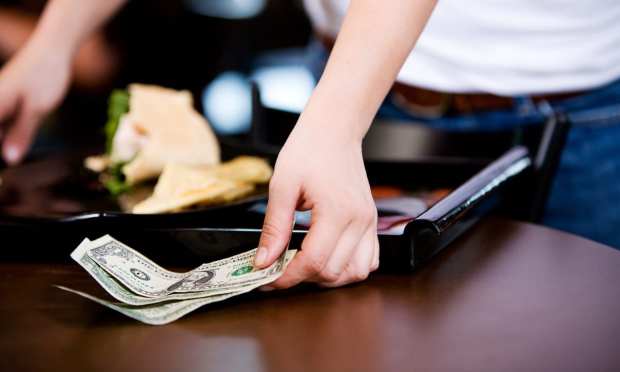GoTab Offers Restaurants Digital Flexibility For Unpredictable Circumstances

While customers may be returning to restaurants, growing comfortable with the prospect of onsite dining, restaurant operators, especially independents, are still facing significant headwinds. Labor shortages and supply chain disruptions are forcing many restaurants to find ways to do more with less. With data showing that restaurants are operating with leaner staffs, even as customers are ordering more, it becomes essential for restaurants’ staff to be as efficient as possible.
To that end, restaurant technology provider GoTab, which creates contactless ordering and payment solutions, recently announced a new “smart tipping” feature to incentivize waitstaff to be more hands-on.
“What we’re trying to do ultimately is make tips more equitable, meaning that they are good for those who work hard and provide good service, and they’re less good for those who don’t,” GoTab CEO Tim McLaughlin told PYMNTS in an interview. “So it’s really a performance-oriented incentive, which humorously everybody tends to think that the tips are performance-oriented but the data wouldn’t support that.”
The feature allows restaurants more flexibility in their tipping structure, providing the ability to pool tips or to apportion tips per item ordered. Along with this feature, the company also announced its “dynamic pricing” feature, an important tool as prices fluctuate amid shortages and supply chain disruptions. After all, no restaurant should be charging pre-shortage prices for, say, chicken wings right now.
Credit Where Credit Is Due
With the smart tipping feature, if a bartender takes a customer’s drink order, a different server takes the entrée order, and the customer orders their own dessert through the company’s digital ordering tools, restaurants can choose to allocate tips accordingly, with tips for self-ordered items going into the pool for all servers. By compensating servers each time they sell a menu item, the feature encourages staff to be on the lookout for sales opportunities.
“The whole point of the server on the floor is to help the guests to interact with the guests, and candidly to upsell the guests, as much as plenty of hospitality people say they don’t want to upsell,” McLaughlin explained.
He added that, with waitstaff checking in more often on customers with, say, an empty glass, the restaurant will either drive more sales or prompt customers who are done with their food or beverage to leave, opening up an opportunity to serve the next customer waiting for the table.
This feature has been in the works since well before the current labor situation, with the idea initially floated in 2019. McLaughlin noted, “We’re kind of academic nerds — we’ve always thought this would be a better way to do it.”
The Price Is Right
Just as the smart tipping feature was not initially created in response to the current labor shortage but nonetheless proves a valuable tool right now, so too did the dynamic pricing feature predate the current restaurant price fluctuations. In fact, the feature already existed through the company’s order rules engine.
McLaughlin noted that this rules engine “lets you really apply any parameter,” allowing restaurant orders to vary price by time of day, by calendar period, or by who is placing the order, among other conditions, with 11 total parameters that can be combined and overlaid.
“It’s a feature we’ve never actually disclosed publicly because no other systems have it, and so we’ve never really had a good way to describe it,” said McLaughlin. Now, however, with the widespread demand for increased flexibility, the company has made the feature known to the public.
Operations on the distributors’ side may be slowed down by the industry’s notoriously old-fashioned methods. As Jordan Huck, chief executive officer of restaurant supply chain technology company Notch, told PYMNTS in a recent interview, “The problem on the distributor side is, their order desk is offline — they receive orders via email, text, phone, fax machines, carrier pigeons.” However, with the ability to adjust prices quickly and easily, this GoTab feature at least allows restaurants to respond as nimbly as possible on their end.
Uber-Like Menu Changing
The feature allows restaurants to adjust menu prices in response to demand, like ridesharing apps’ surge pricing models.
“That’s actually what [operators] were asking for,” recalled McLaughlin. “They said, ‘Hey, can you do this? We want to charge, a quarter more for a margarita on Friday and Saturday night.’”
This sort of pricing, if it catches on across the restaurant industry, could mark a dramatic change in how consumers fit restaurants into their routines. After all, while the first few use cases may be this sort of weekend upcharge (or mid-week discount, depending on how it is framed), as operators grow increasingly accustomed to the technology, the price changes may become increasingly granular. Soon, consumers may be incentivized to visit their favorite restaurant at 3 p.m. on a Monday, just to get mealtime prices.
“The biggest challenge at the restaurant is, if you were to look at our revenue curves or payment curves, they’re so heavily tilted to Friday/Saturday night,” said McLaughlin. “If you can get people to spread out that consumption, it’s a heck of a lot easier to fulfill, and you already have people in the restaurant anyway to staff it.”
